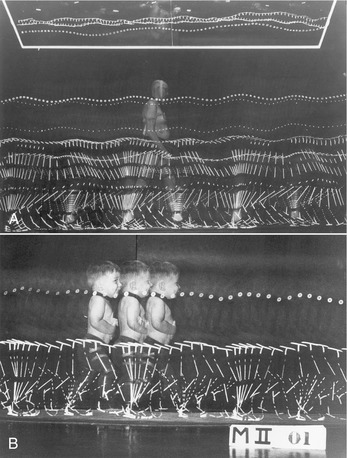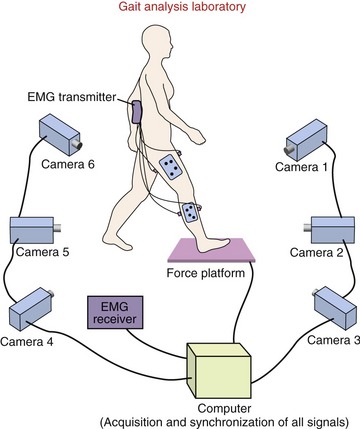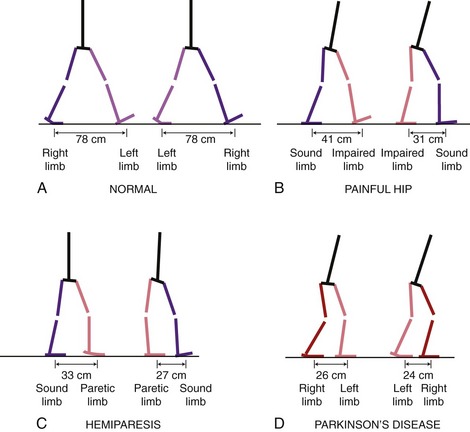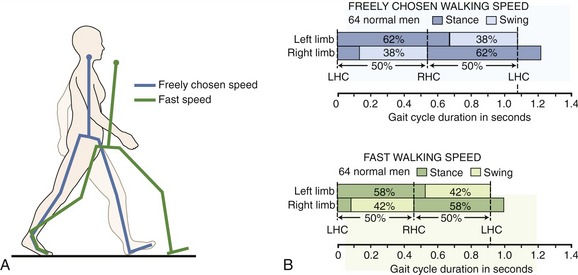Kinesiology of Walking
Walking (ambulation) serves an individual’s basic need to move from place to place and is therefore one of the most common activities that people do on a daily basis. Ideally, walking is performed both efficiently, to minimize fatigue, and safely, to prevent falls and associated injuries.188 Years of practice provide a healthy person with the control needed to ambulate while carrying on a conversation, looking in various directions, and even handling obstacles and other destabilizing forces with minimal effort.
Although a healthy person makes walking seem effortless, the challenge of ambulation can be recognized by looking at individuals at both ends of the lifespan (Figure 15-1). Early in life, the young child needs 11 to 15 months to learn how to stand and walk.67,180 Once on their feet, children will refine their gait so that it visually resembles a mature adult walking pattern by 4 to 5 years of age,26,172,178,179,180 with further refinement taking place over possibly several more years.* Late in life, walking often becomes an increasingly greater challenge. Because of decreased strength, decreased balance, or disease, the elderly may require a cane or walker to ambulate safely. Patla144 eloquently expressed the importance of ambulation in our lives: “Nothing epitomizes a level of independence and our perception of a good quality of life more than the ability to travel independently under our own power from one place to another. We celebrate the development of this ability in children and try to nurture and sustain it throughout the lifespan.”
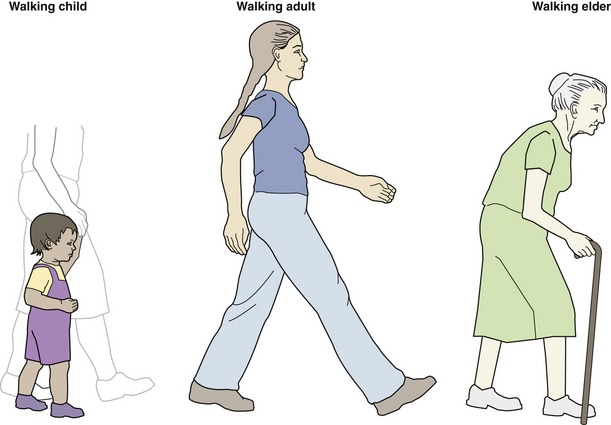
FIGURE 15-1. Walking at various stages in life.
This chapter provides a description of the fundamental kinesiologic characteristics of walking. Unless indicated otherwise, the information provided refers to individuals with a normal and mature gait pattern, walking on level surfaces at a steady average speed. Although this chapter provides enough details to be read independently of the rest of this book, reading Chapters 12 to 14 will facilitate an even greater understanding of walking.
The observation of walking, which is the focus of this chapter, provides information on the outcome of a complex set of “behind the scenes” interactions between sensory and motor functions. For a person to walk, the central nervous system must generate appropriate motor actions from the integration of visual, proprioceptive, and vestibular sensory inputs. Although this chapter covers the intricacy of limb and muscular actions performed during walking, it does not cover the concept of motor control. To gain a greater understanding of the complexity of the motor control of walking, the reader is advised to examine other sources on the topic.*
HISTORICAL PERSPECTIVE OF GAIT ANALYSIS
“If a man were to walk on the ground alongside a wall with a reed dipped in ink attached to his head the line traced by the reed would not be straight but zig-zag, because it goes lower when he bends and higher when he stands upright and raises himself.”6 This early written record by Aristotle (384-322 bc) of observation of walking and numerous earlier paintings and sculptures of individuals engaged in the process of walking are testament that both the casual and detailed observation of ambulation has been of interest throughout history.
Despite this earlier interest, it was not until 1836 that the Weber brothers200 published the first notable scientific work on gait, having benefited from the advances in science provided by individuals such as Galileo Galilei (1564-1642), Giovanni Borelli (1608-1679), and Isaac Newton (1642-1727), to name only a few. Willhelm, a physicist and electrician, and Eduard, an anatomist and physiologist, using instruments such as a stopwatch, a tape measure, and a telescope, described and measured elements of walking, such as step length, cadence, foot-to-ground clearance, and vertical excursion of the body. They also defined basic elements of the gait cycle, such as swing phase, stance phase, and double-limb support periods. Many of the terms they introduced remain in use today. The Webers hypothesized that the basic principle of walking is one of least muscular effort—a concept known to be true today, although the exact methods by which the body minimizes energy expenditure are still being studied.137,209,210 An extensive account of the Weber brothers’ work was published in 1894 and translated in 1992.198,199
In the nineteenth century, other researchers, such as Marey, Carlet, and Vierordt, made use of ingenious technology to expand our knowledge of gait. Most often cited among Marey and Carlet’s many novel methods of measurement are shoes that had air chambers attached to a recorder to indicate the swing and stance phase of gait (Figure 15-2).112,113,114 Another clever idea, by Vierordt, was the use of ink in small spray nozzles attached to the shoes and limbs.189 The ink sprayed on the floor and wall as the individual walked, providing a permanent record of movement.
Concurrently, advances in the field of cinematography created a powerful medium to study and record the kinematic patterns of humans and animals walking. Muybridge may be the most recognized individual of his time to use cinematography to document sequence of movements. Muybridge is most famous for settling an old controversy regarding a trotting horse. In 1872, using sequence photography, he showed that all four feet of a trotting horse are indeed simultaneously off the ground for very brief periods of time. Muybridge created an impressive collection of photographs on human and animal gait, which was initially published in 1887 and assembled and reproduced in 1979.133,134
Initially, the description of gait was limited to planar analyses; the motion was typically recorded in the sagittal plane and less frequently in the frontal plane. Braune and Fisher15,16 are credited as being the first, from 1895 to 1904, to perform a comprehensive three-dimensional analysis of a walking individual. By using four cameras (two pairs of cameras recording motion for each side of the body) and a number of light tubes attached to various body segments, they documented joint kinematics in three dimensions. They were also the first to use the principles of mechanics to measure dynamic quantities such as segmental acceleration, segmental inertial properties, and intersegmental loads (e.g., joint torques and forces). Their analysis of joint torques, limited to the swing phase of gait, refutes the earlier concept, suggested by Weber and Weber in 1836, that lower extremity motion during the swing phase of gait could be explained solely by a passive pendulum theory.201
Throughout the twentieth century, the understanding of walking was greatly enhanced by many scientific advances. Instrumentation to document kinematics evolved from simple video cameras, with film that required painstaking analysis with a ruler and protractor, to highly sophisticated infrared systems, with real-time coordinate data of limb segments. Notable researchers who contributed to the description of the kinematics of gait using a variety of imaging techniques include Eberhart,49 Murray,125,127 Inman,83 Winter,204 and Perry.147 Noteworthy is the work by Murray, a physical therapist and researcher, who published several papers in the 1960s, 1970s, and 1980s describing the kinematics of many aspects of normal and abnormal gait (Figure 15-3).126–128,130,131,176 Among other accomplishments, data from her research—on the kinematics of walking in individuals with disabilities—influenced the design of artificial joints and lower extremity prosthetic limbs.
Similarly, a more extensive understanding of the kinetics of gait was made possible through the development of devices to measure the forces taking place at the foot-ground interface. Amar,2 Elftman,52 Bresler and Frankel,17 and Cunningham and Brown38 all made significant contributions to this field. With the ability to measure the forces between the foot and the ground came computational methods to calculate the forces and torques taking place at the joints of the lower extremities during the stance phase of ambulation.145,166,206
The development of surface and intramuscular electrodes provided the opportunity to record the electrical activity of muscles during gait.62,181 When this information is integrated with the kinematics of walking, the role that each muscle plays during gait can be better appreciated and more objectively described. Many researchers, including Sutherland,179 Perry,147 Inman,83 and Winter,204 have made notable contributions to the study of electromyography (EMG) during walking.
Today, gait analysis is routinely performed in specialized biomechanics laboratories (Figure 15-4). Three-dimensional kinematic data are obtained by using two or more synchronized high-speed cameras. Ground reaction forces are measured using force platforms embedded in the floor. Muscle activity patterns are recorded by multichannel, often telemetered, electromyographic systems. Ultimately, lower extremity joint forces, torques, and powers are calculated with a combination of kinematic data, ground reaction forces, and anthropometric characteristics of the individual (Figure 15-5). These data are then used to describe and study normal and abnormal gait.
Patients with a variety of pathologies can potentially benefit from instrumented gait analyses. Currently the primary beneficiaries of this technology, however, are children with cerebral palsy. In this population, instrumented gait analysis is often used before surgery to help determine the proper intervention. It is employed again after surgery to objectively evaluate the outcome.64 More comprehensive descriptions of the history, tools, and methods used for gait analysis can be found in other sources.7,93,181–183,188,202
Sophisticated technology, such as that described earlier, provides detailed information that can enhance the ability to describe and understand walking. Because such technology is rarely available in the typical clinical setting, clinicians must routinely rely on direct visual observation to evaluate the walking characteristics of their patients.140 Such observational analysis requires a thorough knowledge and understanding of normal gait. Learning about walking, as presented here, is a more dynamic and rewarding experience if the study of this chapter is combined with the observations of gait patterns of relatives, friends, neighbors, and patients in the clinical setting.
SPATIAL AND TEMPORAL DESCRIPTORS
This section describes measurements of distance and time as related to walking.
Gait Cycle
Walking is the result of a cyclic series of movements. As such, it can be conveniently characterized by a detailed description of its most fundamental unit: a gait cycle (Figure 15-6). The gait cycle is initiated as soon as the foot contacts the ground. Because foot contact is normally made with the heel, the 0% point or beginning of the gait cycle is often referred to as heel contact or heel strike. The 100% point or completion of the gait cycle occurs as soon as the same foot once again makes contact with the ground. Initial contact is often used as a substitute term for heel contact when an individual makes first contact with the ground with a part of the foot other than the heel, but for the purpose of this chapter, focusing on normal walking, the term heel contact will be used.
The most basic spatial descriptors of gait include the length of a stride and the length of a step (Figure 15-7). Stride length is the distance between two successive heel contacts of the same foot. Step length, in contrast, is the distance between successive heel contacts of the two different feet. Comparing right with left step lengths can help to evaluate the symmetry of gait between the lower extremities (Figure 15-8). Step width is the lateral distance between the heel centers of two consecutive foot contacts and is on average around 8 to 10 cm (see Figure 15-7).73,111,117,118 Foot angle, the amount of “toe-out,” is the angle between the line of progression of the body and the long axis of the foot. About 5 to 7 degrees is considered average.118 Although the stated norms are for adults, a noteworthy publication80 of data collected from 360 children 7 to 12 years of age documents a normal step width and foot angle of 8 to 10 cm and 2.5 to 6 degrees, respectively—values relatively similar to those in healthy young adults.
Walking speed combines both spatial and temporal measurements by providing information on the distance covered in a given amount of time. The units of measure are typically meters per second (m/sec) or miles per hour (mph). Speed can be calculated by measuring the time it takes to cover a given distance, or the distance covered in a given amount of time, or by multiplying the step rate by the step length. Walking speed varies considerably among individuals based on factors such as age and physical characteristics (e.g., height and weight).36,93 Of all spatial and temporal measurements of gait, speed may be the best and most functional measure of an individual’s walking ability.
For healthy adults, a gait cycle (i.e., two consecutive steps) takes slightly more than 1 second and covers approximately 1.44 m (4.5 feet), resulting in a walking speed of 1.37 m/sec. Data in Table 15-1 indicate that, at a freely chosen walking speed, women exhibit a slower walking speed, shorter step length, and faster cadence than men. These differences are likely in part reflective of anthropometric disparities between genders. Even when anthropometrically matched with men, though, women still demonstrate a higher cadence and shorter step length than men when walking at the same speed.56,129
TABLE 15-1.
Normative Data for Walking Speed, Step Rate, and Step Length

*Males and females are averaged together for these data.
Data obtained from more than 2300 pedestrians unaware of being observed as they walked.
The classic data in Table 15-1 were derived from more than 2300 pedestrians walking outdoors in a large city and who were unaware that their gait characteristics were being measured. Table 15-2 provides data from a select number of studies,* including a smaller number of subjects who walked indoors on an instrumented walkway used to precisely and reliably measure spatial and temporal characteristics of gait. Unlike the pedestrians in the studies in Table 15-1, these subjects were aware that their walking characteristics were being measured, which may account in part for the small differences noted between the data in the two tables.
TABLE 15-2.
Selected Data for Temporal and Spatial Gait Parameters Derived from Individuals Walking in a Laboratory Setting on an Instrumented Walkway*

†Divide cadence by 60 to obtain step rate in steps per second.
*Data are means ± standard deviations, with the exception of Marchetti and colleagues, for whom data are means and 95% confidence intervals. All data are for healthy adults, and all groups include both males and females.
‡The data by Marchetti and colleagues are for left and right step length, and the data by Menz and colleagues are for step length.
The data in Tables 15-1 and 15-2 were collected from individuals walking at their freely chosen speed, which may not always be fast enough to reach a destination in the desired amount of time. When an increase in walking speed is needed, two strategies are available: increasing the stride, or step length, and increasing the cadence (Figure 15-9). Typically an individual combines both strategies until the longest reasonable step length is reached. From that point on, a further increase in walking speed is solely related to an increase in cadence. It must be reemphasized, therefore, that all values (spatial, temporal, kinematic, and kinetic variables) obtained from the measurements of walking vary based on walking speed. For proper reference and interpretation, reports of gait characteristics should always include the walking speed at which the data were collected.
Stance and Swing Phases
To help describe events taking place during the gait cycle, it is customary to subdivide the gait cycle from 0% to 100%. As stated earlier, heel or foot contact with the ground is considered the start of the gait cycle (0%) and the next ground contact made by the same foot is considered the end of the gait cycle (100%). Throughout this chapter, gait is described using the right lower extremity as a reference. A full gait cycle for the right lower extremity can be divided into two major phases: stance and swing (Figure 15-10). Stance phase (from right heel contact to right toe off) occurs as the right foot is on the ground, supporting the body’s weight. Swing phase (from right toe off to the next right heel contact) occurs as the right foot is in the air, being advanced forward for the next contact with the ground. At normal walking speed, the stance phase occupies approximately 60% of the gait cycle, and the swing phase occupies the remaining 40%.

FIGURE 15-10. Subdivision of the gait cycle illustrating the phases of stance and swing and periods of single- and double-limb support.
Within a gait cycle, the body experiences two periods of double-limb support (when both feet are in contact with the ground simultaneously) and two periods of single-limb support (when only one foot is on the ground) (see Figure 15-10


